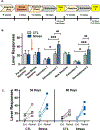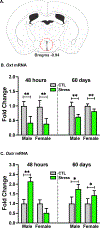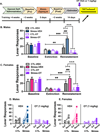Oxytocin Reduces Sensitized Stress-Induced Alcohol Relapse in a Model of Posttraumatic Stress Disorder and Alcohol Use Disorder Comorbidity
- PMID: 36822933
- PMCID: PMC10247903
- DOI: 10.1016/j.biopsych.2022.12.003
Oxytocin Reduces Sensitized Stress-Induced Alcohol Relapse in a Model of Posttraumatic Stress Disorder and Alcohol Use Disorder Comorbidity
Abstract
Background: There is high comorbidity of posttraumatic stress disorder (PTSD) and alcohol use disorder with few effective treatment options. Animal models of PTSD have shown increases in alcohol drinking, but effects of stress history on subsequent vulnerability to alcohol relapse have not been examined. Here we present a mouse model of PTSD involving chronic multimodal stress exposure that resulted in long-lasting sensitization to stress-induced alcohol relapse, and this sensitized stress response was blocked by oxytocin (OT) administration.
Methods: Male and female mice trained to self-administer alcohol were exposed to predator odor (TMT) + yohimbine over 5 consecutive days or left undisturbed. After reestablishing stable alcohol responding/intake, mice were tested under extinction conditions, and then all mice were exposed to TMT or context cues previously associated with TMT before a reinstatement test session. Separate studies examined messenger RNA expression of Oxt and Oxtr in hypothalamus following chronic stress exposure. A final study examined the effects of systemic administration of OT on stress-induced alcohol relapse in mice with and without a history of chronic stress experience.
Results: Chronic stress exposure produced long-lasting sensitization to subsequent stress-induced alcohol relapse that also generalized to stress-related context cues and transcriptional changes in hypothalamic OT system. OT injected before the reinstatement test session completely blocked the sensitized stress-induced alcohol relapse effect.
Conclusions: Collectively, these results provide support for the therapeutic potential of OT, along with highlighting the value of utilizing this model in evaluating other pharmacological interventions for treatment of PTSD/alcohol use disorder comorbidity.
Keywords: Alcohol relapse; Alcohol use disorder; Comorbidity; Oxytocin; Posttraumatic stress disorder; Stress.
Published by Elsevier Inc.
Conflict of interest statement
DISCLOSURES
The authors report no biomedical financial interests or potential conflicts of interest.
Figures






Comment in
-
Alcohol Use Disorder and Posttraumatic Stress Disorder: A Relationship Unbonded by Oxytocin Blockade.Biol Psychiatry. 2023 Aug 1;94(3):189-190. doi: 10.1016/j.biopsych.2023.04.012. Biol Psychiatry. 2023. PMID: 37437989 Free PMC article. No abstract available.
References
-
- Goldstein RB, Smith SM, Chou SP, Saha TD, Jung J, Zhang H, et al. (2016). The epidemiology of DSM-5 posttraumatic stress disorder in the United States: results from the National Epidemiologic Survey on Alcohol and Related Conditions-III. Soc Psychiatry Psychiatr Epidemiol 51(8):1137–1148. - PMC - PubMed
Publication types
MeSH terms
Substances
Grants and funding
LinkOut - more resources
Full Text Sources
Medical

